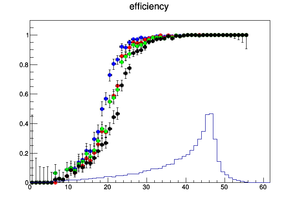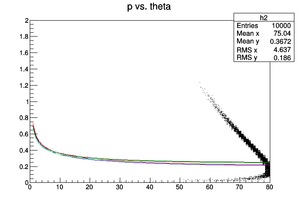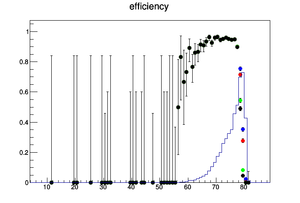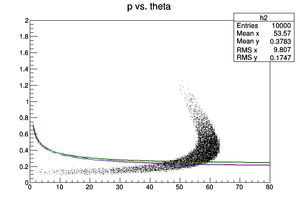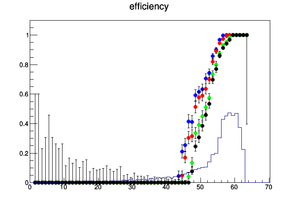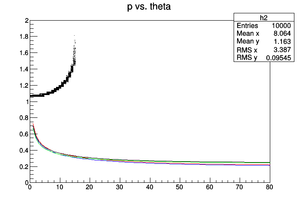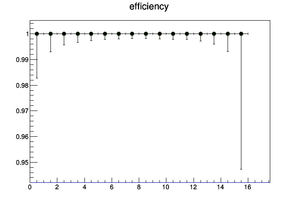Difference between revisions of "Start Counter Material Study"
| Line 1: | Line 1: | ||
| − | We have estimated the effect of the carbon fiber lining for the start counter support structure on the efficiency for detection for protons. Four reactions were studied: | + | We have estimated the effect of the carbon fiber lining for the start counter support structure on the efficiency for detection for protons. Four reactions of the form <math>\gamma p \rightarrow p X</math>were studied: |
| − | # b1pi: genr8, m<sub>X</sub> = 2.0 GeV, width = | + | # b1pi: genr8, m<sub>X</sub> = 2.0 GeV, BW width = 100 MeV |
| − | # bggen1 | + | # bggen1: bggen, m<sub>X</sub> = 2.0 GeV, BW width = 0 |
| − | # bggen2 | + | # bggen2: bggen, m<sub>X</sub> = 2.0 GeV, BW width = 0 |
| − | # bggen3 | + | # bggen3: bggen, m<sub>X</sub> = 2.0 GeV, BW width = 0 |
For each reactions, two definitions of "detected" were considered: | For each reactions, two definitions of "detected" were considered: | ||
Revision as of 00:57, 21 January 2014
We have estimated the effect of the carbon fiber lining for the start counter support structure on the efficiency for detection for protons. Four reactions of the form  were studied:
were studied:
- b1pi: genr8, mX = 2.0 GeV, BW width = 100 MeV
- bggen1: bggen, mX = 2.0 GeV, BW width = 0
- bggen2: bggen, mX = 2.0 GeV, BW width = 0
- bggen3: bggen, mX = 2.0 GeV, BW width = 0
For each reactions, two definitions of "detected" were considered:
- proton emerges from the start counter, with no requirement on momentum ("appeared")
- proton emerges from the start counter with at least 200 MeV/c of total momentum ("tracked")
The material budget is summarized as follows:
Also for each reaction, two detector conditions were considered:
- no carbon fiber support
- nominal (three layer) carbon fiber support
Range and energy loss were calculated using the ??? package. All relevant polar angles were considered. The effect of the magnetic field was not included in this estimate.
Two plots are shown for each reaction:
- momentum vs. polar angle, with the angle dependent cut for each of the following conditions
- "detection" efficiency with the corresponding angular distribution of events in arbitrary units
The colors indicate the definition of "detected" and the absence or presence of the carbon fiber:
- appeared, no carbon fiber (blue)
- appeared, with carbon fiber (red)
- tracked, no carbon fiber (green)
- tracked, with carbon fiber (black)
| reaction | p vs. theta | efficiency |
|---|---|---|
| b1pi | ||
| bggen1 | ||
| bggen2 | ||
| bggen3 |
Integrated over all angles, the various definitions of detection and detector configurations give:
| reaction | appeared, no carbon fiber (blue) | appeared, with carbon fiber (red) | tracked, no carbon fiber (green) | tracked, with carbon fiber (black) |
|---|---|---|---|---|
| b1pi | 0.9386 | 0.9252 | 0.92285 | 0.90845 |
| bggen1 | 0.7429 | 0.725 | 0.6724 | 0.6589 |
| bggen2 | 0.7925 | 0.7749 | 0.73 | 0.7138 |
| bggen3 | 1 | 1 | 1 | 1 |


